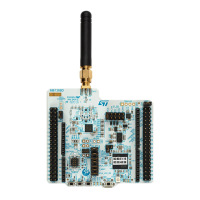RM0453 Rev 5 997/1450
RM0453 Real-time clock (RTC)
1048
When the binary mode is used, the subsecond field can be programmed in the alarm binary
register RTC_ALRMABINR.
The alarm interrupt is enabled through the ALRAIE bit in the RTC_CR register.
Caution: If the seconds field is selected (MSK1 bit reset in RTC_ALRMAR), the synchronous
prescaler division factor set in the RTC_PRER register must be at least 3 to ensure correct
behavior.
Alarm A and alarm B (if enabled by bits OSEL[1:0] in RTC_CR register) can be routed to the
TAMPALRM output. TAMPALRM output polarity can be configured through bit POL the
RTC_CR register.
32.3.8 Periodic auto-wake-up
The periodic wake-up flag is generated by a 16-bit programmable auto-reload down-
counter. The wake-up timer range can be extended to 17 bits.
The wake-up function is enabled through the WUTE bit in the RTC_CR register.
The wake-up timer clock input ck_wut can be:
• RTC clock (RTCCLK) divided by 2, 4, 8, or 16.
When RTCCLK is LSE (32.768 kHz), this allows the wake-up interrupt period to be
configured from 122 µs to 32 s, with a resolution down to 61 µs.
• ck_spre (usually 1 Hz internal clock) in BCD mode, or the clock used to update the
calendar as defined by BCDU in binary or mixed (BCD-binary) modes.
When ck_spre frequency is 1 Hz, this allows a wake-up time to be achieved from 1 s to
around 36 hours with one-second resolution. This large programmable time range is
divided in 2 parts:
– from 1 s to 18 hours when WUCKSEL [2:1] = 10
– and from around 18 h to 36 h when WUCKSEL[2:1] = 11. In this last case 2
16
is
added to the 16-bit counter current value. When the initialization sequence is
complete (see Programming the wake-up timer on page 1000), the timer starts
counting down. When the wake-up function is enabled, the down-counting
remains active in low-power modes. In addition, when it reaches 0, the WUTF flag
is set in the RTC_SR register, and the wake-up counter is automatically reloaded
with its reload value (RTC_WUTR register value).
Depending on WUTOCLR in the RTC_WUTR register, the WUTF flag must either be
cleared by software (WUTOCLR = 0x0000), or the WUTF is automatically cleared by
hardware when the auto-reload down counter reaches WUTOCLR value
(0x0000<WUTOCLR<=WUT).
The wake-up flag is output on an internal signal rtc_wut that can be used by other
peripherals (refer to section Section 32.3.1: RTC block diagram).
When the periodic wake-up interrupt is enabled by setting the WUTIE bit in the RTC_CR
register, it can exit the device from low-power modes.
The periodic wake-up flag can be routed to the TAMPALRM output provided it has been
enabled through bits OSEL[1:0] of RTC_CR register. TAMPALRM output polarity can be
configured through the POL bit in the RTC_CR register.
System reset, as well as low-power modes (Sleep, Stop and Standby) have no influence on
the wake-up timer.

